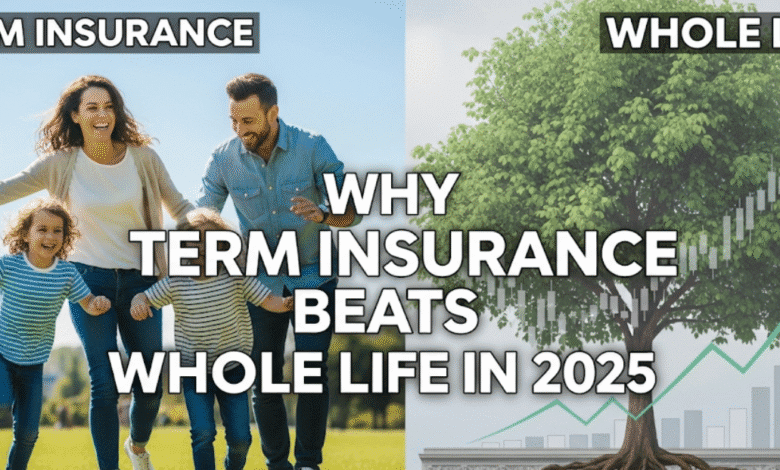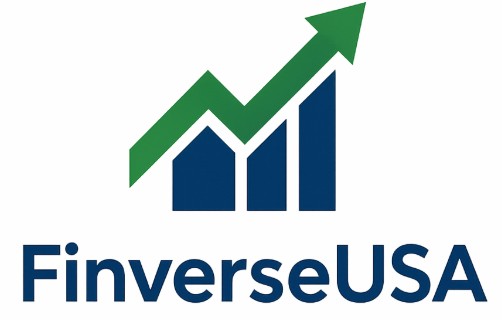
The process of selecting life insurance can seem overwhelming. But with dozens of offerings, and with sales pitches that promise everything from retirement funds to investment returns, it can be a headache to figure out which is the best. But here’s the truth, which insurance salespeople don’t want you to know: term life insurance will utterly smash whole life insurance in pretty much any scenario that matters to real families in 2025.
This isn’t the usual insurance comparison. Today we are going to outline why term insurance has undoubtedly won out as the best option for today’s families and we’re going to do it with real numbers and current market data that will make the decision a no brainer once you see the math.
The Insurance Playbook Will Never Be The Same Again
The world of insurance in 2025 is very different from anything we’ve seen in the past even five years. Interest rates are rising, inflation fears are looming and a new generation of tech-savvy consumers have turned everything we thought we knew about what makes financial sense upside down.
Term life insurance has grown up into a streamlined, powerful financial tool that, quite simply, does what life insurance is supposed to do: protect your family if something happens to you. Meanwhile, whole life insurance is still rounding up expensive features that most families don’t need and can’t afford.
What Makes 2025 Different
There are a few important reasons why term insurance is the bright choice this year:
Digital Revolution: Online insurance sites have drastically cut the price of term policies, and comparing prices has become a snap. You can now obtain quotes from dozens of insurers within minutes, instead of the weeks it used to take.
Market Transparency: Recent regulations have forced clearer fee and return disclosures, revealing how expensive whole life insurance actually is.
Investment Options: You can invest the difference between a term and whole life premiums much more effectively than any insurance company could ever do with robo-advisors and low-cost index funds.
Perhaps the Most Convincing Reason: Term Life Insurance is Simply the Best Choice
Term life insurance is similar to auto insurance and home insurance. You pay a premium, and if you die during the coverage window, your heirs get the death benefit. No cumbersome cash values, no difficult-to-understand investment components, just simple protection.
Why Term Rules in 2025
Pure Protection at Unbeatable Prices
A 35-year-old in good health might be able to find $500,000 in term life insurance for somewhere in the range of $25-40 a month. That same person would be looking at $400-600 per month for the same level of whole life coverage. That’s not a typo – a whole life policy will cost you 10-15X more for the same death benefit.
Flexibility When Life Changes
Term policies also offer the flexibility to change the amount of coverage as your needs change. Earned a promotion and want more coverage? Easy. Kids left and you don’t need as much? Simple. Whole life policies trap you in decade-long commitments with steep surrender charges, should you need to make changes.
No Hidden Costs Eating up Your Money
With term insurance the fees are low because there are no complex moving parts to handle. You’re paying for insurance, period. Whole life policies are embedded with administrative costs, management expenses, and sales commissions that may eat up 50-90% of what you contribute in the first year.
Real-World Term Insurance Benefits
| Coverage Amount | Age 35 (20-year term) | Age 45 (20-year term) | Age 55 (10-year term) |
|---|---|---|---|
| $250,000 | $15-25/month | $25-40/month | $60-90/month |
| $500,000 | $25-40/month | $45-70/month | $110-160/month |
| $1,000,000 | $40-65/month | $80-125/month | $200-300/month |
Premiums for preferred risk rates, healthy nonsmokers
Whole Life Insurance: An Expensive Illusion
Whole life insurance claims to be life insurance and an investment account bundled into one neat package. It sounds good but then you figure out what you actually get for that premium.
The Costs You Don’t See That Are Killing Your Returns
Front-Loaded Expenses
There are currently surrender charges for the first 10-20 years on whole life policies. If you were to cancel or downgrade your policy, you’d lose thousands of dollars. Such charges can run as high as 50 percent during the early years, based on your cash value.
Opportunity Cost Disaster
The “cash value” part of whole life grows at about 2-4% every year. By contrast, an easy-to-own S&P 500 index fund has provided a return of more than 10% annually over the long term. You’re losing 6-8% returns annually to purchase costly insurance.
Complex Fee Structure
Whole life policies are full of fees for a variety of reasons:
- Administrative fees (annual)
- Cost of insurance charges (monthly)
- Service loads (percent of each payment)
- Surrender charges (if you cancel)
- Policy loan interest (if you borrow on the cash value)
Why the “Investment” Component Fails
Insurance companies aren’t investment managers. They’re risk managers who invest your money in a conservative enough way that there will always be a return. And with their overhead and profit margins, that conservatism means your money grows slower than it would in a savings account in many cases.
The Buy Term and Invest the Difference System
Here is where term insurance can be a wealth-building workhorse. Instead of spending $500/month for whole life you pay $50/month for term insurance and you invest $450 in real investment accounts.
The Math That Changes Everything
Let’s put two 35-year-olds side by side over 30 years:
Person A: Whole Life Insurance
- Premium: $500 per month ($180,000 over 30 years)
- Death benefit: $500,000
- Cash value after 30 years: ~$220,000
- Total wealth: $220,000
Person B: Term Life and Investments
- Term premium: $50/month
- Investment: $450/month
- Death benefit: $500,000 (first 20 years), then the investments provide protection
- Investment value at the end of 30 years (assuming 7% return): $510,000
- Total wealth: $510,000
Person B winds up with over twice the total wealth, in addition to the same protection in case Person A passed away.
Investments That Outperform Whole Life
Low-Cost Index Funds
- Total stock market index funds: 0.03% annual fee
- Target-date funds: 0.15% annual fee
- Both give you diversified exposure to thousands of companies
Robo-Advisors
- Automated rebalancing and tax-loss harvesting
- Fees typically 0.25-0.50% annually
- Professional management, without the human advisor costs
Employer 401(k) Plans
- Many include company matching (free money)
- Tax advantages that insurance cannot match
- Frequently feature low-cost index fund choices
When Term Insurance Really Works
Young Families with Mortgages
If you have small children and a mortgage, term insurance is a no-brainer. You want maximum coverage at the lowest cost during your peak-risk, low-income years. A $1 million term policy can mean your family can keep the house and the kids can go to college if something happens to you.
Top Earners in Their Prime
Many people in their 30s and 40s have the greatest insurance needs and the best investment opportunities. Term insurance safeguards their family’s lifestyle as they create wealth through investment, real estate, and business.
People Planning for Retirement
Term insurance fills the gap until your own investments grow large enough for you to self-insure. Kids are grown, house is paid off and your spouse will be taken care of through your investment portfolio (without life insurance) upon your death.
When Whole Life Might (Rarely) Make Sense
Ultra-High Net Worth Estate Planning
Families worth more than $12 million per person could use whole life for estate tax planning. The death benefit may provide liquidity to pay estate taxes without having to sell family businesses or assets.
Special Needs Planning
Some parents of special needs children may need permanent insurance to provide for lifetime care. Whole life’s guaranteed death benefit ensures the insurance will be in place no matter how your health status may change.
Business Buy-Sell Agreements
Some business partners use whole life insurance to fund buy-sell agreements, but term insurance usually does an equally good job for far less money.
Selecting the Best Term Policy in 2025
Coverage Amount Formula
Basic needs approach:
- Outstanding debts (mortgage, loans): $X
- Income replacement (10x annual income): $Y
- Future goals (college, final expenses): $Z
- Total needed: $X + $Y + $Z
- Subtract existing savings and insurance
Term Length Decision
20-Year Term: Best for most young families, especially those with mortgages and young children
30-Year Term: Good for very young families and for those who want longer rate guarantees
10-Year Term: For temporary needs or older applicants
Top Features to Demand
- Level Premium Coverage: The cost of your coverage will never go up for the life of your policy
- Convertible Options: Convert to permanent without medical exam
- Excellent Financial Ratings: Insurer rated A+ or better by AM Best
- Claims Paying Speed: Research the company’s claims-paying history
Smart Shopping Strategies for 2025
Use Multiple Quote Sources
Don’t put all your eggs in one website or agent. Insurers have different types of risks they prefer or specialize in, so compare quotes from:
- Direct online insurers
- Traditional life insurance companies
- Professional insurance brokers

Time Your Application Right
Best application months: January, February, March (insurers want to start with a strong year)
Health timing: Apply when you are healthy and have had no major medical issues
Age timing: Apply before your next birthday to lock in younger rates
Medical Exam Tips
- Schedule your appointment in the morning (for better test accuracy)
- Avoid caffeine, coffee, tea and soft drinks that can be overstimulating
- Avoid strenuous exercise before the exam
- Bring a list of medications and dosages you are taking
- Don’t lie about health history (lying means no policy)
Common Mistakes That Cost Thousands
Buying Too Little Coverage
The average family underestimates its insurance needs by 50% or more. It’s far better to have more coverage than you need than to leave your family in financial straits.
Choosing the Wrong Term Length
Getting 10-year term if you need 20 years of coverage will likely result in a steep increase in rates when the term ends and you’re older and possibly in worse health.
Ignoring the Insurance Company’s Stability
A bargain premium from a struggling insurer isn’t a bargain if they can’t pay claims. Stick with financially strong companies, even if they are more expensive.
Not Reading the Fine Print
Some policies have gotchas like:
- Premium increases for certain diseases
- Limited convertibility windows
- Special exclusions for certain activities or occupations
The Future of Life Insurance
Technology Disruption
Artificial intelligence and wearables are changing life insurance. Some insurers are starting to offer policies based on fitness tracker data which has the potential to reduce costs for people who are healthy.
Simplified Underwriting
More no-exam policies are being offered for smaller amounts, and insurers are increasingly turning to algorithms, rather than medical exams, to evaluate risk. This makes it easier and faster than ever to get the coverage you need.
Customizable Policies
New policy formats allow you to change coverage levels and term lengths, and even convert to permanent insurance — all with more flexibility in mind.
Frequently Asked Questions
Is term life insurance less expensive than whole life insurance?
Yes, term life insurance is much less expensive than whole life insurance. For example, a 35-year-old could expect to pay $30 to $50 a month for $500,000 in term coverage and up to $400 to $600 for the same whole life policy. Term insurance is 10-15 times cheaper because it is pure insurance without costlier investment aspects.
What happens when my term policy expires?
When your term expires, you can renew it at higher rates based on your current age, convert it to permanent coverage without taking a medical exam (if your policy includes the conversion feature), or let it lapse if you no longer need coverage. Most people discover that they no longer need a life insurance policy when their term ends, once their children are grown and their debts are paid off.
Can I change term insurance to whole life later?
The vast majority of high-quality term policies contain conversion privileges, allowing you to convert to permanent insurance without evidence of insurability, usually within the first 10-20 years of the policy. But the cost of the permanent policy will be based on your age at the time of conversion, so it will be expensive. It is usually wiser to invest the premium difference than to convert.
Why do insurance sales agents push whole life and not term?
Agents make much larger commissions on whole life policies – often 50-100% of the first year’s premium while they make 10-20% on term policies. A $500 monthly whole life product can produce $3,000-6,000 in first year commissions; a $50 monthly term product can produce $60-120. This provides a powerful financial incentive to push expensive products.
Is cash value in whole life insurance worth it?
The cash value in whole life usually grows at 2-4% per year, far under the amount you could earn by investing the premium difference into index funds (8-10% per year historically). There are also conditions, fees, and surrender charges tied to the cash value, which makes it a poor investment when compared to real investment accounts.
How much term life insurance should I buy?
It is generally accepted that you should aim to have 10-12 times your annual income, but your individual needs will vary based on your debt, dependents, and financial goals. Factor in your mortgage balance, other debts, need for income replacement, children’s education expenses and final expenses. Many financial advisors suggest you buy at least enough to cover your mortgage and replace five to 10 years of your income.
Is it possible to get term life insurance online?
Yes, you can get term life insurance online directly from numerous insurance companies. For smaller amounts (generally up to around $250,000-$500,000), you could be eligible for simplified underwriting and no medical exam. Larger amounts generally require a phone interview and medical exam, but the entire process can still be initiated and applied for online.
What if I become ill during my term?
Your level term life insurance rates are locked-in for the coverage time period and stay the same, even if your health condition changes. You do not have to worry that your rates will increase during the term if you become seriously ill. But if you seek to renew or purchase new coverage following the end of the term, your health conditions will affect the price and eligibility.
Choose Smart for Your Family’s Future
Between term and whole life insurance, there isn’t really a choice in 2025. Term gives you better protection, lower expenses, greater flexibility, and the ability to develop actual wealth through actual investments.
Don’t let the insurance salespeople tell you that complexity is better. The best financial products are often the simplest. That’s exactly what term life insurance does: protect your family when they need it most, and not get in the way of your other financial goals.
Your family deserves protection as well as prosperity. Term life insurance provides both, and whole life insurance provides neither very efficiently. The math is clear, the benefits are obvious and the time to act is now.
Take the money you would be spending on whole life premiums and develop a real investment portfolio. Your future self — and your family — will thank you for making the smart decision that prioritized their financial security.

